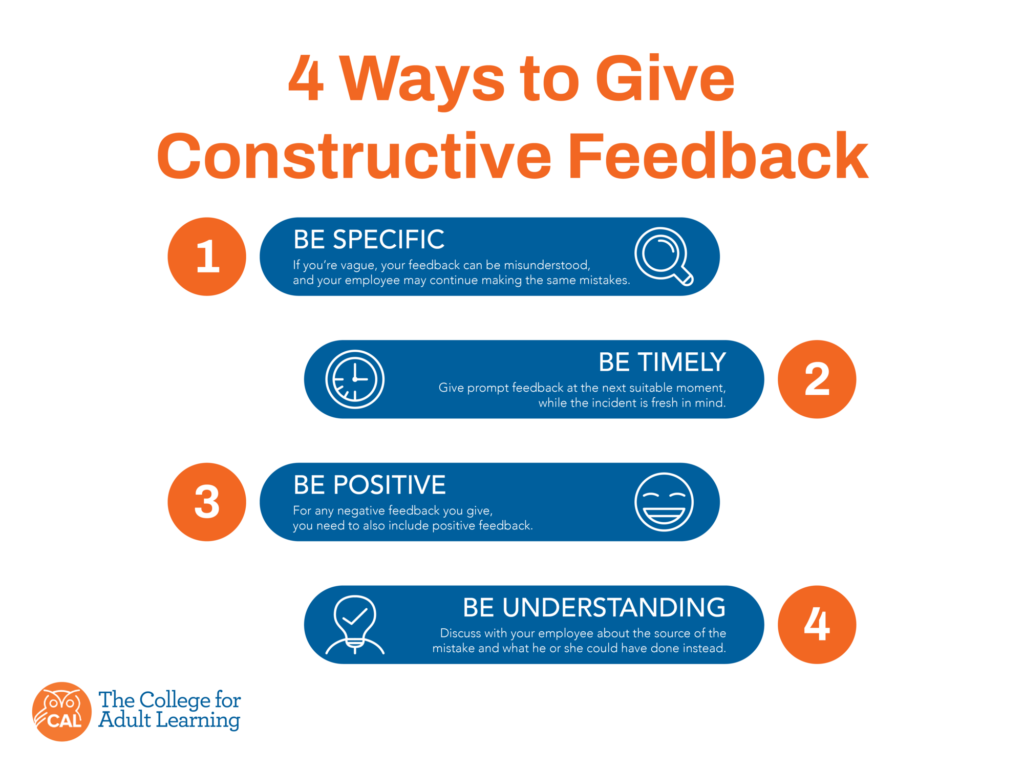
Giving constructive feedback to employees can be a daunting task for managers. Many managers say it is the least favourite part of the position. However, as difficult as it is, being able to do so effectively can have long-lasting results for all involved. Often the employee will be doing many things well and it is only certain specific areas that need to be improved. It is also tempting to let things slide until performance review time rolls around. However, this is not always prudent or desirable. A session of constructive feedback now can save a lengthy and uncomfortable performance review later. By tackling the issue early, you can expect an increase in the performance of the employee, as well as improved interpersonal relationships and a far more productive work environment for everyone.
To communicate your ideas constructively, it’s important that you get your message across in a way that isn’t detrimental and find ways to give constructive feedback without being intimidating. Naturally, you want to boost an employee’s self-confidence and work ethic rather than take the wind from their sails.

Four Simple Tips to Follow To Give Constructive Feedback
Be Specific
Get to the point quickly and make sure that you don’t beat around the bush. If you’re vague, your feedback can be misunderstood, and your employee may continue making the same mistakes. Tell your employee the exact instance where they have made a mistake and outline what they can do differently. Prepare notes if necessary with specific examples of the incidents. If it is an interpersonal issue, you can also try role-playing to tackle the issue effectively. If it is operational, perhaps you need to walk them through the correct steps or redo the procedure manual to be clearer.
Be Timely
Give prompt feedback at the next suitable moment, while the incident is fresh in mind. If you wait too long to give feedback, then the potency will be lost. An immediate response to their action will allow them to associate it with your feedback. This increases the likelihood that they will retain the feedback, take on the learning, and be wary of when they may make the same mistake again.
Be Positive
For any negative feedback you give, you need to include positive feedback. Approach the criticism in a positive, solution-orientated way and focus on your employee’s strengths. Again, prepare notes about their strengths as well as the areas that need correcting. You want to build self-esteem and encourage on-the-job learning and growth. Agree on what measures will be implemented to support the employee in improving. It can be a good idea to set a review time now for a week or two later, so they have a clear timeframe of your expectations. Reiterate that you are available at any time if they have questions or need further coaching.
Be Understanding
Discuss with your employee about the source of the mistake and what he or she could have done instead. Work together to figure out whether your employee needs any extra assistance with their job and offer them help where they may need it. You might be surprised by their ideas to improve systems or procedures for everyone. Use this feedback time as a learning opportunity for both you and your employee.
Reflecting on constructive feedback
When you are competent and willing to provide constructive feedback to your employees, it enables them to work more efficiently to your expectations. It also gives you more insight into how you can improve in managing your employees day-to-day, what additional training they may require, and prompt further thoughts about what you can do to keep them motivated. Perhaps it is also time for a staff function, to implement a staff member of the month scheme or conduct an overall staff satisfaction feedback survey.
The best leaders and managers are those who are able to help their team thrive and come into their full potential. Constructive feedback doesn’t need to be a negative thing – when you can follow it up with actionable steps and assistance for the person you can make big changes in their performance and within your company. Next time you find yourself in a position where constructive feedback is necessary, follow our four easy steps to ensure it goes smoothly.
A Diploma of Leadership & Management (BSB50420) will harness the interpersonal and practical skills you need to give constructive feedback wisely. Become the very best leader you can be, and propel your career into a management position with our self-paced, online qualification. Speak to one of our Learning Coaches to find out more.





